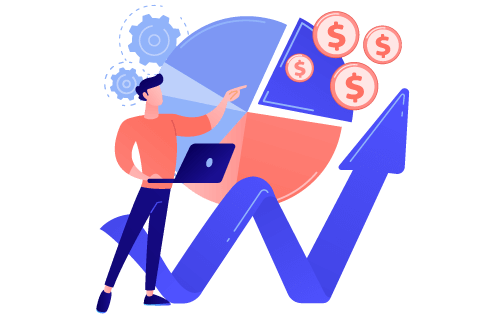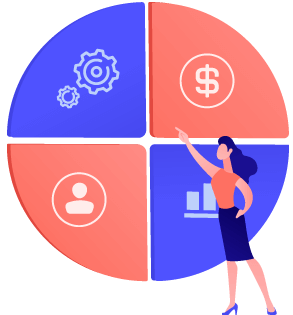Forecasting Demand Accurately
Built For


- Different types of demand forecasting
- Key factors that influence demand
- The game-changing benefits of getting your forecasts right
- How to overcome common challenges
- Why inventory software outshines manual methods
- Best practices for maintaining your forecasts
Forecasting Demand Accurately
Imagine always having precisely what your customers want, exactly when they want it. Sounds like a dream, right? Well, that’s the magic of accurate demand forecasting. It’s the process that helps businesses predict future customer demand, ensuring they can meet it efficiently and effectively.
But how does it work, and why is it so crucial? Today, we discuss demand forecasting, explore its benefits, and discuss how technology can help you master it.
Understanding Demand Forecasting
Predicting future customer demand for a product is demand forecasting. Forecasting demand accurately enables businesses to make informed decisions about their inventory levels, production schedules, and more.
Types of Demand Forecasting
- Qualitative Forecasting: This method relies on expert opinions and market research. It’s beneficial when launching new products or entering new markets.
- Quantitative Forecasting: This method uses historical data and statistical models to predict future demand. It’s highly accurate when there is ample historical data available.
Key Factors Influencing Demand
- Seasonality: Products may have seasonal demand fluctuations.
- Market Trends: Changes in consumer preferences and market conditions.
- Economic Indicators: Economic health can significantly impact consumer spending.
Benefits of Accurate Demand Forecasting

Accurate demand forecasting brings a treasure trove of benefits:
- Improved Inventory Management: By knowing what products are in demand, you can maintain optimal inventory levels, avoiding overstocking and stockouts. This balance reduces storage costs and minimizes waste.
- Enhanced Customer Satisfaction: Consistently meeting customer demand boosts customer loyalty and happy customers more often recommend your business to others.
- Increased Profitability and Cost Savings: Efficient inventory management reduces holding costs and minimizes losses from unsold goods, ultimately boosting your bottom line. Accurate forecasting also helps negotiate better terms with suppliers based on anticipated demand.
- Better Resource Allocation: Allocate resources more effectively across your supply chain, from raw materials to workforce planning.
- Informed Marketing Strategies: Use demand insights to plan promotions and marketing campaigns that align with customer needs and market trends.
Challenges in Demand Forecasting
Of course, forecasting isn’t without its challenges:
- Data Inaccuracies and Inconsistencies: Garbage in, garbage out. If your data is flawed, your forecasts will be too. Ensuring data accuracy is paramount.
- Rapidly Changing Market Conditions: The market can be unpredictable, with trends shifting quickly and unexpectedly.
- Complexity of Integrating Various Data Sources: Combining data from multiple sources can be tricky, but it’s essential for accurate forecasting. Ensuring seamless data integration requires robust systems and processes.
- Bias in Forecasting: Personal biases of those involved in forecasting can skew predictions.
- Technological Limitations: Not all businesses can access advanced forecasting tools, such as those in inventory software, limiting their forecasting accuracy.
Steps to Implement Accurate Demand Forecasting
Implementing accurate demand forecasting involves several key steps:
- Data Cleaning: Ensure your data is accurate and free of inconsistencies.
- Identify and Collect Relevant Data: Gather historical sales data, market trends, and other relevant information. This may include customer feedback, economic indicators, and competitive analysis.
- Choose the Right Forecasting Methods and Models: Select models that best fit your business needs, whether it’s time-series analysis, causal models, or others. Combining multiple models can often yield the best results.
- Regularly Review and Adjust Forecasts: Compare your forecasts with actual sales data and make necessary adjustments to improve accuracy. Regular review cycles help to refine the forecasting process and incorporate new data and trends.
- Model Testing: Test different forecasting models to determine the best accuracy for your specific situation.
- Feedback Loops: Implement feedback loops where forecast accuracy is regularly evaluated and models are adjusted accordingly.
Using Inventory Software for Demand Forecasting

Inventory software can collect and analyze vast amounts of data, providing insights that manual methods simply can’t match.
- Data Cleaning: Ensure your data is accurate and free of inconsistencies.
- Identify and Collect Relevant Data: Gather historical sales data, market trends, and other relevant information. This may include customer feedback, economic indicators, and competitive analysis.
- Choose the Right Forecasting Methods and Models: Select models that best fit your business needs, whether it’s time-series analysis, causal models, or others. Combining multiple models can often yield the best results.
- Regularly Review and Adjust Forecasts: Compare your forecasts with actual sales data and make necessary adjustments to improve accuracy. Regular review cycles help to refine the forecasting process and incorporate new data and trends.
- Model Testing: Test different forecasting models to determine the best accuracy for your specific situation.
- Feedback Loops: Implement feedback loops where forecast accuracy is regularly evaluated and models are adjusted accordingly.
Best Practices for Maintaining Forecast Accuracy
To keep your forecasts sharp, follow these best practices:
- Continuous Monitoring and Adjustment: Regularly update your forecasts based on the latest market conditions and sales data. This proactive approach helps in adapting to changes swiftly.
- Collaboration Between Departments: Ensure sales, marketing, and operations teams collaborate to provide accurate input and feedback. Cross-departmental collaboration ensures that all perspectives are considered.
- Scenario Planning: Prepare for different market scenarios by creating multiple forecast models.
Understanding and predicting customer demand can optimize your inventory, boost customer satisfaction, and increase profitability. With the right tools and practices, forecasting can become a cornerstone of your business strategy, turning uncertainty into opportunity.
Forecasting demand accurately isn’t just about numbers and data; it’s about being prepared, staying agile, and always having the right products at the right time. Embrace the power of demand forecasting and watch your business thrive. Happy forecasting!
Call us at 817-870-1311





